Analysing the Evolution of Departmental and Discount Stores in Retail
VerifiedAdded on 2023/06/07
|10
|2820
|282
Report
AI Summary
This report examines the evolution of departmental and discount stores within the Australian retail industry, highlighting the impact of digital revolution and changing consumer patterns. It delves into the characteristics of both departmental and discount stores, contrasting their target customers, competitive advantages, and operational strategies. The report further explores the retail lifecycle and the wheel of retailing, providing a framework for understanding market entry, expansion, and competitive dynamics. It identifies key driving forces behind the growth of the Australian retail sector, such as advanced marketing, economic factors, and customer preferences. The analysis also considers future trends, including the rise of multichannel platforms, e-commerce, and the integration of artificial intelligence, while also noting the potential disruption to the labor market. The report concludes by emphasizing the need for innovation and technology adoption to ensure business sustainability and competitive advantage in the face of new market entrants.

The changing face of retailing: How departmental stores and discount stores are
evolving
evolving
Paraphrase This Document
Need a fresh take? Get an instant paraphrase of this document with our AI Paraphraser
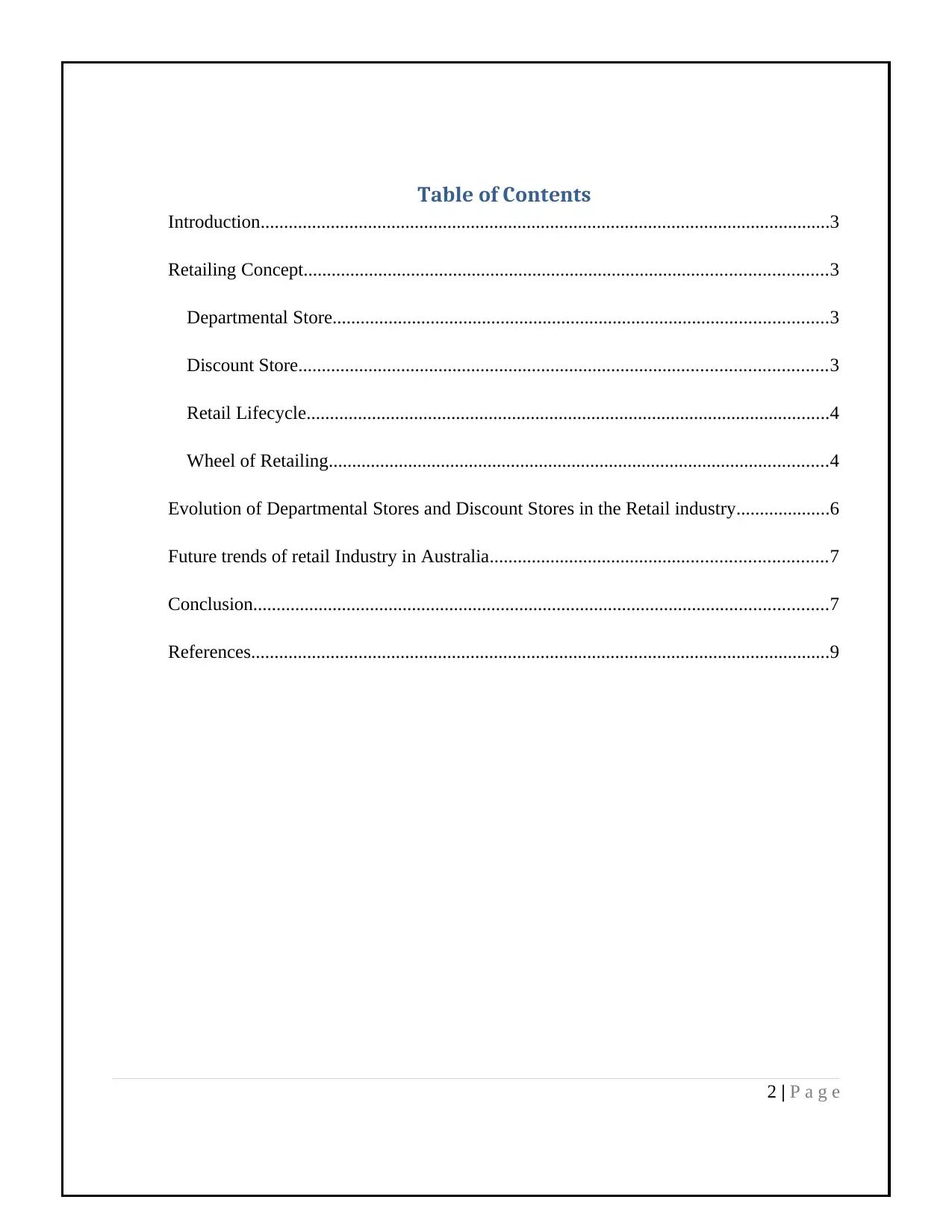
Table of Contents
Introduction..........................................................................................................................3
Retailing Concept................................................................................................................3
Departmental Store..........................................................................................................3
Discount Store.................................................................................................................3
Retail Lifecycle................................................................................................................4
Wheel of Retailing...........................................................................................................4
Evolution of Departmental Stores and Discount Stores in the Retail industry....................6
Future trends of retail Industry in Australia........................................................................7
Conclusion...........................................................................................................................7
References............................................................................................................................9
2 | P a g e
Introduction..........................................................................................................................3
Retailing Concept................................................................................................................3
Departmental Store..........................................................................................................3
Discount Store.................................................................................................................3
Retail Lifecycle................................................................................................................4
Wheel of Retailing...........................................................................................................4
Evolution of Departmental Stores and Discount Stores in the Retail industry....................6
Future trends of retail Industry in Australia........................................................................7
Conclusion...........................................................................................................................7
References............................................................................................................................9
2 | P a g e
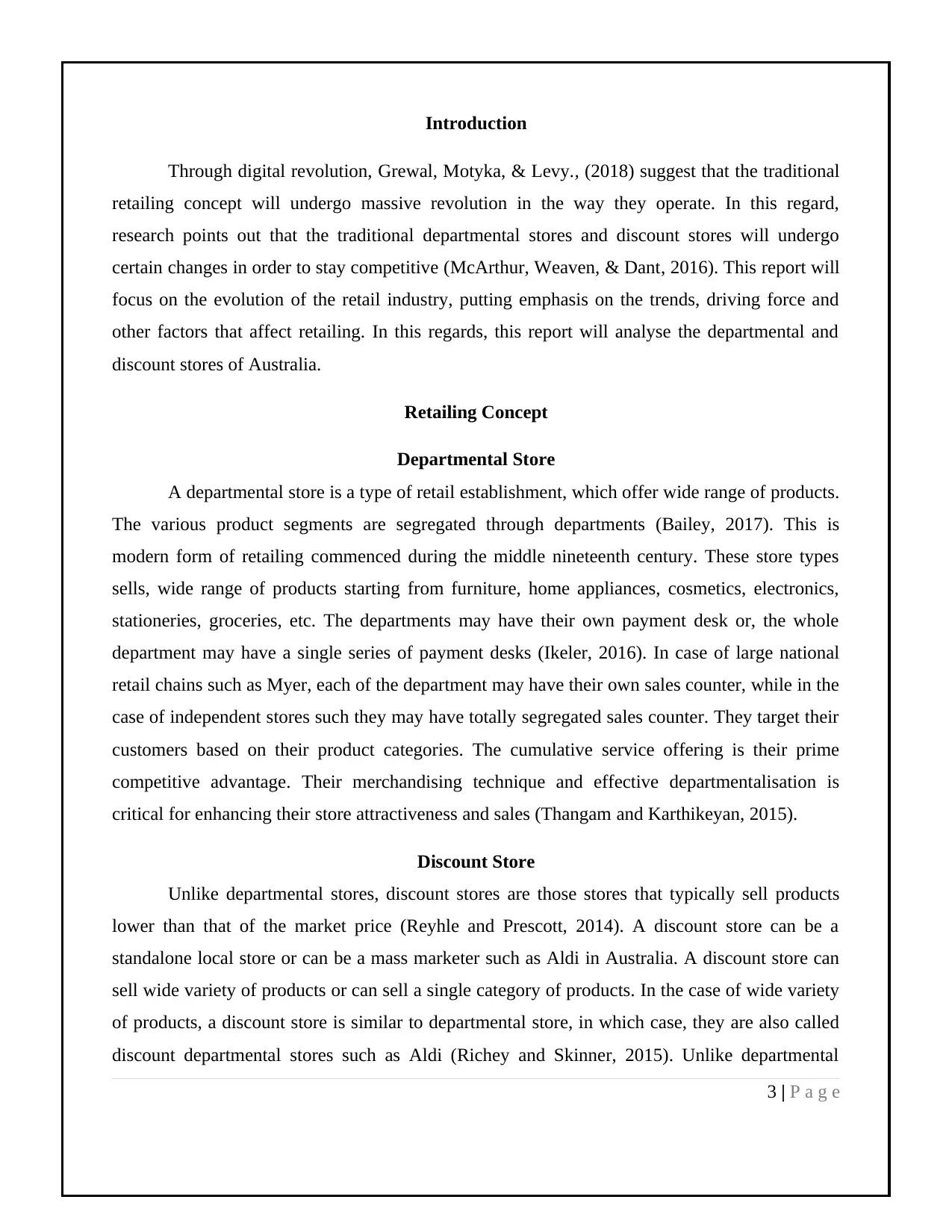
Introduction
Through digital revolution, Grewal, Motyka, & Levy., (2018) suggest that the traditional
retailing concept will undergo massive revolution in the way they operate. In this regard,
research points out that the traditional departmental stores and discount stores will undergo
certain changes in order to stay competitive (McArthur, Weaven, & Dant, 2016). This report will
focus on the evolution of the retail industry, putting emphasis on the trends, driving force and
other factors that affect retailing. In this regards, this report will analyse the departmental and
discount stores of Australia.
Retailing Concept
Departmental Store
A departmental store is a type of retail establishment, which offer wide range of products.
The various product segments are segregated through departments (Bailey, 2017). This is
modern form of retailing commenced during the middle nineteenth century. These store types
sells, wide range of products starting from furniture, home appliances, cosmetics, electronics,
stationeries, groceries, etc. The departments may have their own payment desk or, the whole
department may have a single series of payment desks (Ikeler, 2016). In case of large national
retail chains such as Myer, each of the department may have their own sales counter, while in the
case of independent stores such they may have totally segregated sales counter. They target their
customers based on their product categories. The cumulative service offering is their prime
competitive advantage. Their merchandising technique and effective departmentalisation is
critical for enhancing their store attractiveness and sales (Thangam and Karthikeyan, 2015).
Discount Store
Unlike departmental stores, discount stores are those stores that typically sell products
lower than that of the market price (Reyhle and Prescott, 2014). A discount store can be a
standalone local store or can be a mass marketer such as Aldi in Australia. A discount store can
sell wide variety of products or can sell a single category of products. In the case of wide variety
of products, a discount store is similar to departmental store, in which case, they are also called
discount departmental stores such as Aldi (Richey and Skinner, 2015). Unlike departmental
3 | P a g e
Through digital revolution, Grewal, Motyka, & Levy., (2018) suggest that the traditional
retailing concept will undergo massive revolution in the way they operate. In this regard,
research points out that the traditional departmental stores and discount stores will undergo
certain changes in order to stay competitive (McArthur, Weaven, & Dant, 2016). This report will
focus on the evolution of the retail industry, putting emphasis on the trends, driving force and
other factors that affect retailing. In this regards, this report will analyse the departmental and
discount stores of Australia.
Retailing Concept
Departmental Store
A departmental store is a type of retail establishment, which offer wide range of products.
The various product segments are segregated through departments (Bailey, 2017). This is
modern form of retailing commenced during the middle nineteenth century. These store types
sells, wide range of products starting from furniture, home appliances, cosmetics, electronics,
stationeries, groceries, etc. The departments may have their own payment desk or, the whole
department may have a single series of payment desks (Ikeler, 2016). In case of large national
retail chains such as Myer, each of the department may have their own sales counter, while in the
case of independent stores such they may have totally segregated sales counter. They target their
customers based on their product categories. The cumulative service offering is their prime
competitive advantage. Their merchandising technique and effective departmentalisation is
critical for enhancing their store attractiveness and sales (Thangam and Karthikeyan, 2015).
Discount Store
Unlike departmental stores, discount stores are those stores that typically sell products
lower than that of the market price (Reyhle and Prescott, 2014). A discount store can be a
standalone local store or can be a mass marketer such as Aldi in Australia. A discount store can
sell wide variety of products or can sell a single category of products. In the case of wide variety
of products, a discount store is similar to departmental store, in which case, they are also called
discount departmental stores such as Aldi (Richey and Skinner, 2015). Unlike departmental
3 | P a g e
⊘ This is a preview!⊘
Do you want full access?
Subscribe today to unlock all pages.

Trusted by 1+ million students worldwide
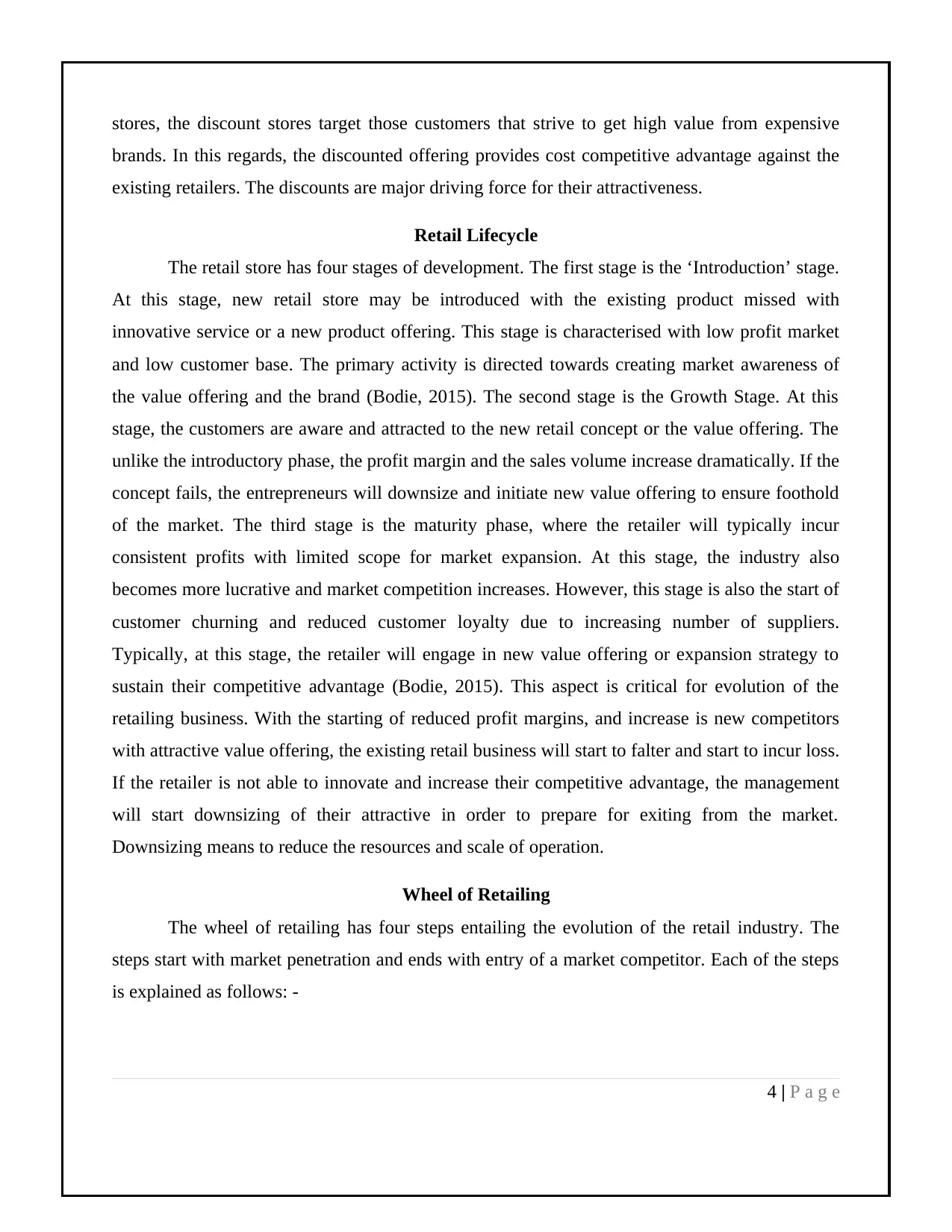
stores, the discount stores target those customers that strive to get high value from expensive
brands. In this regards, the discounted offering provides cost competitive advantage against the
existing retailers. The discounts are major driving force for their attractiveness.
Retail Lifecycle
The retail store has four stages of development. The first stage is the ‘Introduction’ stage.
At this stage, new retail store may be introduced with the existing product missed with
innovative service or a new product offering. This stage is characterised with low profit market
and low customer base. The primary activity is directed towards creating market awareness of
the value offering and the brand (Bodie, 2015). The second stage is the Growth Stage. At this
stage, the customers are aware and attracted to the new retail concept or the value offering. The
unlike the introductory phase, the profit margin and the sales volume increase dramatically. If the
concept fails, the entrepreneurs will downsize and initiate new value offering to ensure foothold
of the market. The third stage is the maturity phase, where the retailer will typically incur
consistent profits with limited scope for market expansion. At this stage, the industry also
becomes more lucrative and market competition increases. However, this stage is also the start of
customer churning and reduced customer loyalty due to increasing number of suppliers.
Typically, at this stage, the retailer will engage in new value offering or expansion strategy to
sustain their competitive advantage (Bodie, 2015). This aspect is critical for evolution of the
retailing business. With the starting of reduced profit margins, and increase is new competitors
with attractive value offering, the existing retail business will start to falter and start to incur loss.
If the retailer is not able to innovate and increase their competitive advantage, the management
will start downsizing of their attractive in order to prepare for exiting from the market.
Downsizing means to reduce the resources and scale of operation.
Wheel of Retailing
The wheel of retailing has four steps entailing the evolution of the retail industry. The
steps start with market penetration and ends with entry of a market competitor. Each of the steps
is explained as follows: -
4 | P a g e
brands. In this regards, the discounted offering provides cost competitive advantage against the
existing retailers. The discounts are major driving force for their attractiveness.
Retail Lifecycle
The retail store has four stages of development. The first stage is the ‘Introduction’ stage.
At this stage, new retail store may be introduced with the existing product missed with
innovative service or a new product offering. This stage is characterised with low profit market
and low customer base. The primary activity is directed towards creating market awareness of
the value offering and the brand (Bodie, 2015). The second stage is the Growth Stage. At this
stage, the customers are aware and attracted to the new retail concept or the value offering. The
unlike the introductory phase, the profit margin and the sales volume increase dramatically. If the
concept fails, the entrepreneurs will downsize and initiate new value offering to ensure foothold
of the market. The third stage is the maturity phase, where the retailer will typically incur
consistent profits with limited scope for market expansion. At this stage, the industry also
becomes more lucrative and market competition increases. However, this stage is also the start of
customer churning and reduced customer loyalty due to increasing number of suppliers.
Typically, at this stage, the retailer will engage in new value offering or expansion strategy to
sustain their competitive advantage (Bodie, 2015). This aspect is critical for evolution of the
retailing business. With the starting of reduced profit margins, and increase is new competitors
with attractive value offering, the existing retail business will start to falter and start to incur loss.
If the retailer is not able to innovate and increase their competitive advantage, the management
will start downsizing of their attractive in order to prepare for exiting from the market.
Downsizing means to reduce the resources and scale of operation.
Wheel of Retailing
The wheel of retailing has four steps entailing the evolution of the retail industry. The
steps start with market penetration and ends with entry of a market competitor. Each of the steps
is explained as follows: -
4 | P a g e
Paraphrase This Document
Need a fresh take? Get an instant paraphrase of this document with our AI Paraphraser

Step 1: The first step is market entry of a new type of retailer in a market for example, in
the Australian retail market. This stage incorporates attractive margins and innovative
procedure. For example, in Australia, David Jones through partnership with Appleton
started the Appleton & Jones stores at Sydney in Australia in 1835 (McArthur et al. 2016).
This stage is aimed at gaining a foothold and creating awareness among the customers. The
attractive margins and unique value attracts prospective customers to these stores. At this
stage, foreign retailers often engage into mergers and partnerships in order to capitalise on
the customer base and experience of the local retailer. For example, David Jones merged
with Appleton to create the retail brand Appleton & Jones.
Step 2: The second step is to gain experience in the local market and expand to new
market. The main aim is to increase the customer base and dramatically increase their
market share. Initially their profits stay low due to mass discounts. However, through
experience and market expansion, it is essential for Appleton & Jones to expand their
market (McArthur et al. 2016). Hence, they expand their operation throughout Australia.
Similarly, in the case of Aldi, the renowned discount departmental stores in Australia,
started at a single location and then expand their operations across the nation (McArthur et
al. 2016). It is essential to note that at this stage Aldi diversified their business to
incorporate more product categories other than groceries. Diversification is the strategy to
increase their competitive advantage and increase the customer base. Diversification
includes adoption of new product segment with new features and value offerings.
Step 3: By the end of the stage 3, the retail brand has already established themselves in the
market and incurring high volume of sales. Hence, at this stage, the retailer will utilise their
experience of the market and expand into new regions within the nation of globally in order
to enhance their profitability. Further, the local competition may downsize due to the
pressure of competition. At this stage, the retailer will also invest into optimising their cost
of operation. Cost containment along with market expansion is the forte of this stage.
Step 4: At this stage of the retailing business, new competition may enter the market, which
will eventually bring down the market share of this retailer. In this regards, the cost of
5 | P a g e
the Australian retail market. This stage incorporates attractive margins and innovative
procedure. For example, in Australia, David Jones through partnership with Appleton
started the Appleton & Jones stores at Sydney in Australia in 1835 (McArthur et al. 2016).
This stage is aimed at gaining a foothold and creating awareness among the customers. The
attractive margins and unique value attracts prospective customers to these stores. At this
stage, foreign retailers often engage into mergers and partnerships in order to capitalise on
the customer base and experience of the local retailer. For example, David Jones merged
with Appleton to create the retail brand Appleton & Jones.
Step 2: The second step is to gain experience in the local market and expand to new
market. The main aim is to increase the customer base and dramatically increase their
market share. Initially their profits stay low due to mass discounts. However, through
experience and market expansion, it is essential for Appleton & Jones to expand their
market (McArthur et al. 2016). Hence, they expand their operation throughout Australia.
Similarly, in the case of Aldi, the renowned discount departmental stores in Australia,
started at a single location and then expand their operations across the nation (McArthur et
al. 2016). It is essential to note that at this stage Aldi diversified their business to
incorporate more product categories other than groceries. Diversification is the strategy to
increase their competitive advantage and increase the customer base. Diversification
includes adoption of new product segment with new features and value offerings.
Step 3: By the end of the stage 3, the retail brand has already established themselves in the
market and incurring high volume of sales. Hence, at this stage, the retailer will utilise their
experience of the market and expand into new regions within the nation of globally in order
to enhance their profitability. Further, the local competition may downsize due to the
pressure of competition. At this stage, the retailer will also invest into optimising their cost
of operation. Cost containment along with market expansion is the forte of this stage.
Step 4: At this stage of the retailing business, new competition may enter the market, which
will eventually bring down the market share of this retailer. In this regards, the cost of
5 | P a g e
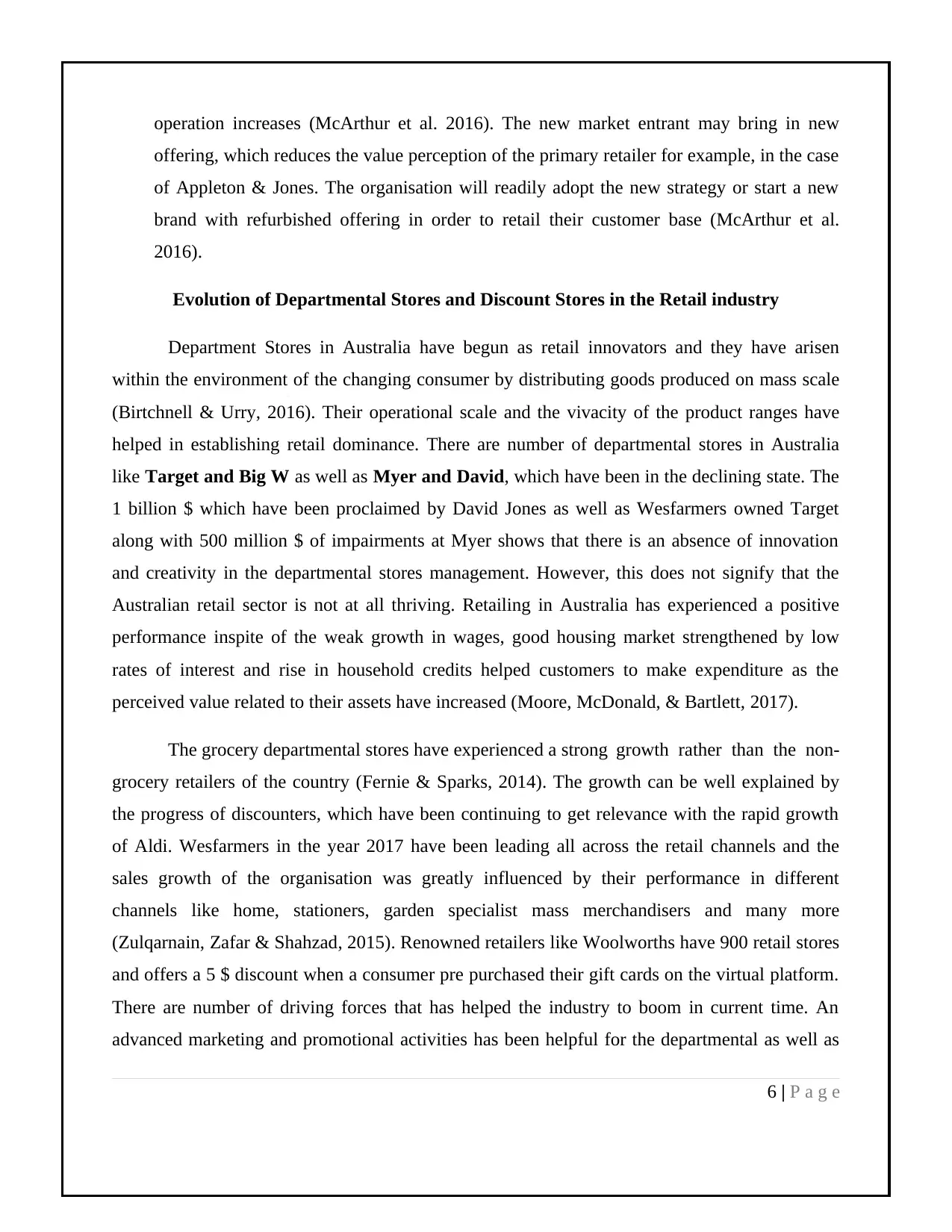
operation increases (McArthur et al. 2016). The new market entrant may bring in new
offering, which reduces the value perception of the primary retailer for example, in the case
of Appleton & Jones. The organisation will readily adopt the new strategy or start a new
brand with refurbished offering in order to retail their customer base (McArthur et al.
2016).
Evolution of Departmental Stores and Discount Stores in the Retail industry
Department Stores in Australia have begun as retail innovators and they have arisen
within the environment of the changing consumer by distributing goods produced on mass scale
(Birtchnell & Urry, 2016). Their operational scale and the vivacity of the product ranges have
helped in establishing retail dominance. There are number of departmental stores in Australia
like Target and Big W as well as Myer and David, which have been in the declining state. The
1 billion $ which have been proclaimed by David Jones as well as Wesfarmers owned Target
along with 500 million $ of impairments at Myer shows that there is an absence of innovation
and creativity in the departmental stores management. However, this does not signify that the
Australian retail sector is not at all thriving. Retailing in Australia has experienced a positive
performance inspite of the weak growth in wages, good housing market strengthened by low
rates of interest and rise in household credits helped customers to make expenditure as the
perceived value related to their assets have increased (Moore, McDonald, & Bartlett, 2017).
The grocery departmental stores have experienced a strong growth rather than the non-
grocery retailers of the country (Fernie & Sparks, 2014). The growth can be well explained by
the progress of discounters, which have been continuing to get relevance with the rapid growth
of Aldi. Wesfarmers in the year 2017 have been leading all across the retail channels and the
sales growth of the organisation was greatly influenced by their performance in different
channels like home, stationers, garden specialist mass merchandisers and many more
(Zulqarnain, Zafar & Shahzad, 2015). Renowned retailers like Woolworths have 900 retail stores
and offers a 5 $ discount when a consumer pre purchased their gift cards on the virtual platform.
There are number of driving forces that has helped the industry to boom in current time. An
advanced marketing and promotional activities has been helpful for the departmental as well as
6 | P a g e
offering, which reduces the value perception of the primary retailer for example, in the case
of Appleton & Jones. The organisation will readily adopt the new strategy or start a new
brand with refurbished offering in order to retail their customer base (McArthur et al.
2016).
Evolution of Departmental Stores and Discount Stores in the Retail industry
Department Stores in Australia have begun as retail innovators and they have arisen
within the environment of the changing consumer by distributing goods produced on mass scale
(Birtchnell & Urry, 2016). Their operational scale and the vivacity of the product ranges have
helped in establishing retail dominance. There are number of departmental stores in Australia
like Target and Big W as well as Myer and David, which have been in the declining state. The
1 billion $ which have been proclaimed by David Jones as well as Wesfarmers owned Target
along with 500 million $ of impairments at Myer shows that there is an absence of innovation
and creativity in the departmental stores management. However, this does not signify that the
Australian retail sector is not at all thriving. Retailing in Australia has experienced a positive
performance inspite of the weak growth in wages, good housing market strengthened by low
rates of interest and rise in household credits helped customers to make expenditure as the
perceived value related to their assets have increased (Moore, McDonald, & Bartlett, 2017).
The grocery departmental stores have experienced a strong growth rather than the non-
grocery retailers of the country (Fernie & Sparks, 2014). The growth can be well explained by
the progress of discounters, which have been continuing to get relevance with the rapid growth
of Aldi. Wesfarmers in the year 2017 have been leading all across the retail channels and the
sales growth of the organisation was greatly influenced by their performance in different
channels like home, stationers, garden specialist mass merchandisers and many more
(Zulqarnain, Zafar & Shahzad, 2015). Renowned retailers like Woolworths have 900 retail stores
and offers a 5 $ discount when a consumer pre purchased their gift cards on the virtual platform.
There are number of driving forces that has helped the industry to boom in current time. An
advanced marketing and promotional activities has been helpful for the departmental as well as
6 | P a g e
⊘ This is a preview!⊘
Do you want full access?
Subscribe today to unlock all pages.

Trusted by 1+ million students worldwide
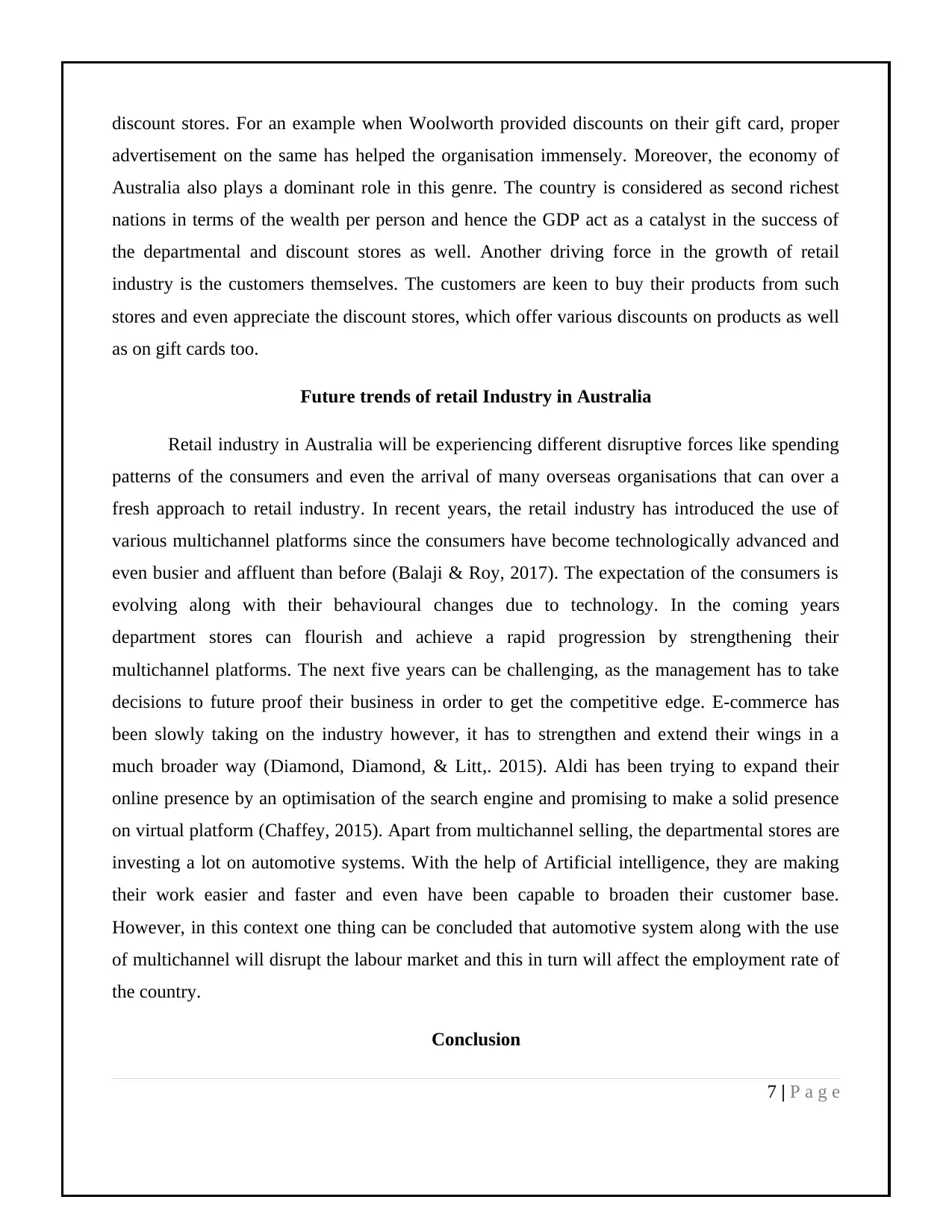
discount stores. For an example when Woolworth provided discounts on their gift card, proper
advertisement on the same has helped the organisation immensely. Moreover, the economy of
Australia also plays a dominant role in this genre. The country is considered as second richest
nations in terms of the wealth per person and hence the GDP act as a catalyst in the success of
the departmental and discount stores as well. Another driving force in the growth of retail
industry is the customers themselves. The customers are keen to buy their products from such
stores and even appreciate the discount stores, which offer various discounts on products as well
as on gift cards too.
Future trends of retail Industry in Australia
Retail industry in Australia will be experiencing different disruptive forces like spending
patterns of the consumers and even the arrival of many overseas organisations that can over a
fresh approach to retail industry. In recent years, the retail industry has introduced the use of
various multichannel platforms since the consumers have become technologically advanced and
even busier and affluent than before (Balaji & Roy, 2017). The expectation of the consumers is
evolving along with their behavioural changes due to technology. In the coming years
department stores can flourish and achieve a rapid progression by strengthening their
multichannel platforms. The next five years can be challenging, as the management has to take
decisions to future proof their business in order to get the competitive edge. E-commerce has
been slowly taking on the industry however, it has to strengthen and extend their wings in a
much broader way (Diamond, Diamond, & Litt,. 2015). Aldi has been trying to expand their
online presence by an optimisation of the search engine and promising to make a solid presence
on virtual platform (Chaffey, 2015). Apart from multichannel selling, the departmental stores are
investing a lot on automotive systems. With the help of Artificial intelligence, they are making
their work easier and faster and even have been capable to broaden their customer base.
However, in this context one thing can be concluded that automotive system along with the use
of multichannel will disrupt the labour market and this in turn will affect the employment rate of
the country.
Conclusion
7 | P a g e
advertisement on the same has helped the organisation immensely. Moreover, the economy of
Australia also plays a dominant role in this genre. The country is considered as second richest
nations in terms of the wealth per person and hence the GDP act as a catalyst in the success of
the departmental and discount stores as well. Another driving force in the growth of retail
industry is the customers themselves. The customers are keen to buy their products from such
stores and even appreciate the discount stores, which offer various discounts on products as well
as on gift cards too.
Future trends of retail Industry in Australia
Retail industry in Australia will be experiencing different disruptive forces like spending
patterns of the consumers and even the arrival of many overseas organisations that can over a
fresh approach to retail industry. In recent years, the retail industry has introduced the use of
various multichannel platforms since the consumers have become technologically advanced and
even busier and affluent than before (Balaji & Roy, 2017). The expectation of the consumers is
evolving along with their behavioural changes due to technology. In the coming years
department stores can flourish and achieve a rapid progression by strengthening their
multichannel platforms. The next five years can be challenging, as the management has to take
decisions to future proof their business in order to get the competitive edge. E-commerce has
been slowly taking on the industry however, it has to strengthen and extend their wings in a
much broader way (Diamond, Diamond, & Litt,. 2015). Aldi has been trying to expand their
online presence by an optimisation of the search engine and promising to make a solid presence
on virtual platform (Chaffey, 2015). Apart from multichannel selling, the departmental stores are
investing a lot on automotive systems. With the help of Artificial intelligence, they are making
their work easier and faster and even have been capable to broaden their customer base.
However, in this context one thing can be concluded that automotive system along with the use
of multichannel will disrupt the labour market and this in turn will affect the employment rate of
the country.
Conclusion
7 | P a g e
Paraphrase This Document
Need a fresh take? Get an instant paraphrase of this document with our AI Paraphraser
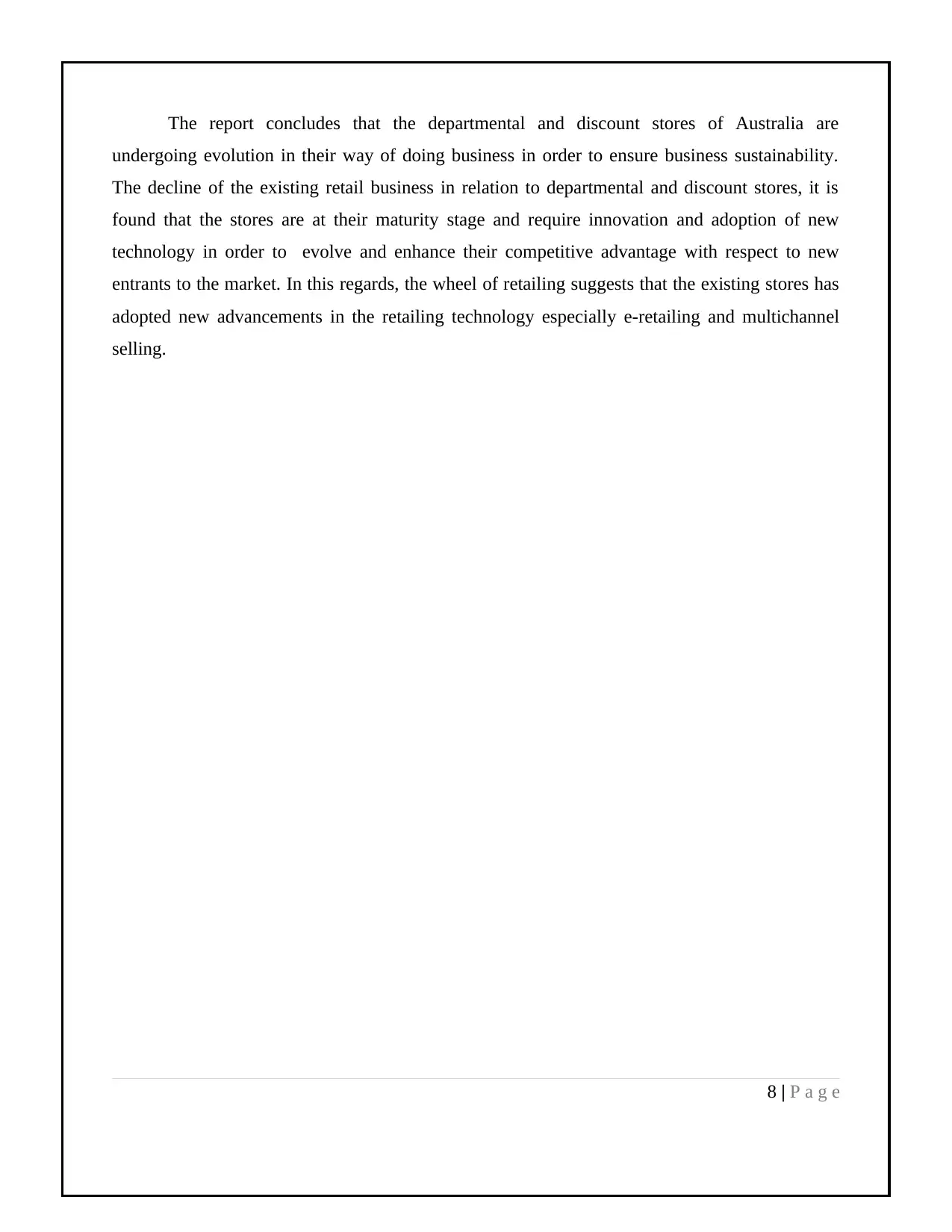
The report concludes that the departmental and discount stores of Australia are
undergoing evolution in their way of doing business in order to ensure business sustainability.
The decline of the existing retail business in relation to departmental and discount stores, it is
found that the stores are at their maturity stage and require innovation and adoption of new
technology in order to evolve and enhance their competitive advantage with respect to new
entrants to the market. In this regards, the wheel of retailing suggests that the existing stores has
adopted new advancements in the retailing technology especially e-retailing and multichannel
selling.
8 | P a g e
undergoing evolution in their way of doing business in order to ensure business sustainability.
The decline of the existing retail business in relation to departmental and discount stores, it is
found that the stores are at their maturity stage and require innovation and adoption of new
technology in order to evolve and enhance their competitive advantage with respect to new
entrants to the market. In this regards, the wheel of retailing suggests that the existing stores has
adopted new advancements in the retailing technology especially e-retailing and multichannel
selling.
8 | P a g e
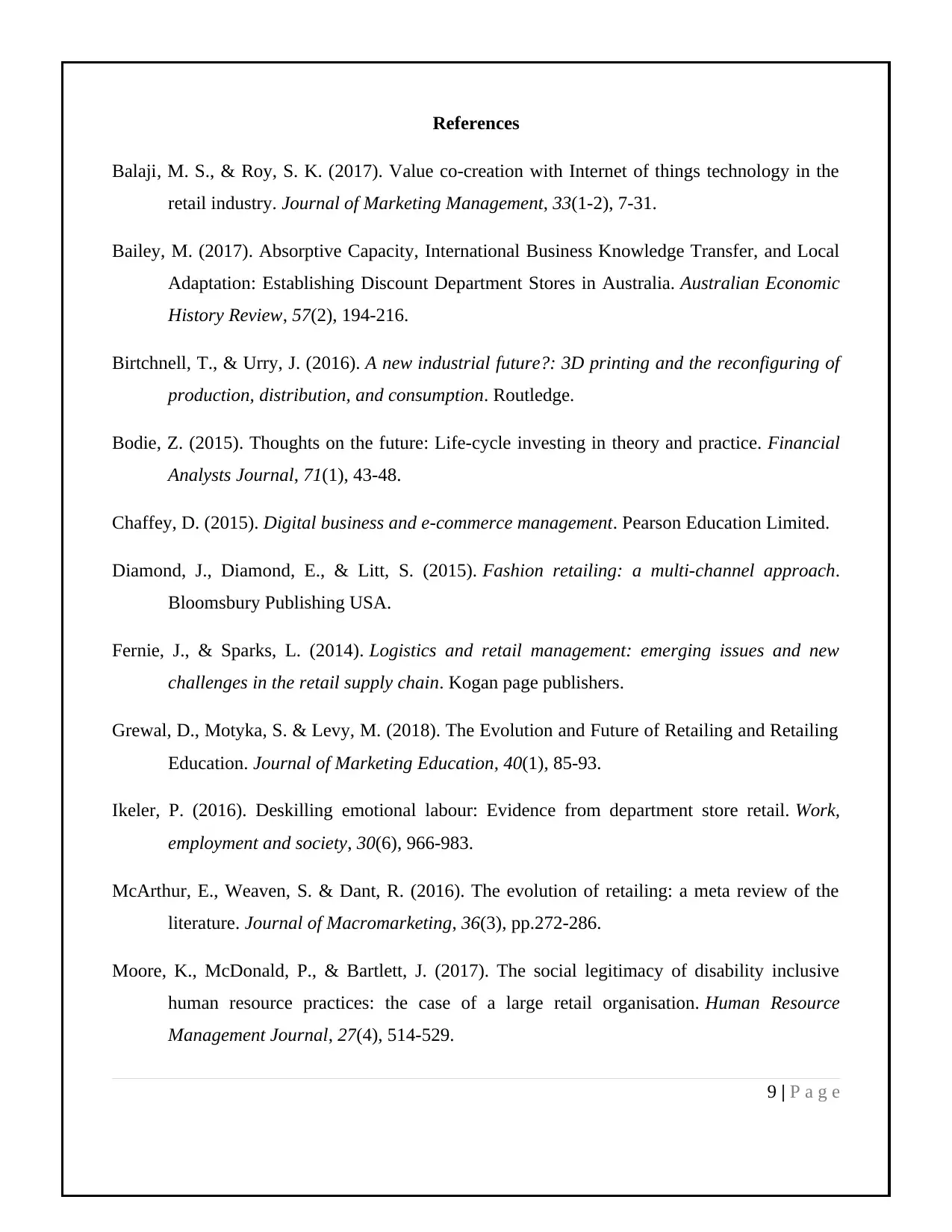
References
Balaji, M. S., & Roy, S. K. (2017). Value co-creation with Internet of things technology in the
retail industry. Journal of Marketing Management, 33(1-2), 7-31.
Bailey, M. (2017). Absorptive Capacity, International Business Knowledge Transfer, and Local
Adaptation: Establishing Discount Department Stores in Australia. Australian Economic
History Review, 57(2), 194-216.
Birtchnell, T., & Urry, J. (2016). A new industrial future?: 3D printing and the reconfiguring of
production, distribution, and consumption. Routledge.
Bodie, Z. (2015). Thoughts on the future: Life-cycle investing in theory and practice. Financial
Analysts Journal, 71(1), 43-48.
Chaffey, D. (2015). Digital business and e-commerce management. Pearson Education Limited.
Diamond, J., Diamond, E., & Litt, S. (2015). Fashion retailing: a multi-channel approach.
Bloomsbury Publishing USA.
Fernie, J., & Sparks, L. (2014). Logistics and retail management: emerging issues and new
challenges in the retail supply chain. Kogan page publishers.
Grewal, D., Motyka, S. & Levy, M. (2018). The Evolution and Future of Retailing and Retailing
Education. Journal of Marketing Education, 40(1), 85-93.
Ikeler, P. (2016). Deskilling emotional labour: Evidence from department store retail. Work,
employment and society, 30(6), 966-983.
McArthur, E., Weaven, S. & Dant, R. (2016). The evolution of retailing: a meta review of the
literature. Journal of Macromarketing, 36(3), pp.272-286.
Moore, K., McDonald, P., & Bartlett, J. (2017). The social legitimacy of disability inclusive
human resource practices: the case of a large retail organisation. Human Resource
Management Journal, 27(4), 514-529.
9 | P a g e
Balaji, M. S., & Roy, S. K. (2017). Value co-creation with Internet of things technology in the
retail industry. Journal of Marketing Management, 33(1-2), 7-31.
Bailey, M. (2017). Absorptive Capacity, International Business Knowledge Transfer, and Local
Adaptation: Establishing Discount Department Stores in Australia. Australian Economic
History Review, 57(2), 194-216.
Birtchnell, T., & Urry, J. (2016). A new industrial future?: 3D printing and the reconfiguring of
production, distribution, and consumption. Routledge.
Bodie, Z. (2015). Thoughts on the future: Life-cycle investing in theory and practice. Financial
Analysts Journal, 71(1), 43-48.
Chaffey, D. (2015). Digital business and e-commerce management. Pearson Education Limited.
Diamond, J., Diamond, E., & Litt, S. (2015). Fashion retailing: a multi-channel approach.
Bloomsbury Publishing USA.
Fernie, J., & Sparks, L. (2014). Logistics and retail management: emerging issues and new
challenges in the retail supply chain. Kogan page publishers.
Grewal, D., Motyka, S. & Levy, M. (2018). The Evolution and Future of Retailing and Retailing
Education. Journal of Marketing Education, 40(1), 85-93.
Ikeler, P. (2016). Deskilling emotional labour: Evidence from department store retail. Work,
employment and society, 30(6), 966-983.
McArthur, E., Weaven, S. & Dant, R. (2016). The evolution of retailing: a meta review of the
literature. Journal of Macromarketing, 36(3), pp.272-286.
Moore, K., McDonald, P., & Bartlett, J. (2017). The social legitimacy of disability inclusive
human resource practices: the case of a large retail organisation. Human Resource
Management Journal, 27(4), 514-529.
9 | P a g e
⊘ This is a preview!⊘
Do you want full access?
Subscribe today to unlock all pages.

Trusted by 1+ million students worldwide
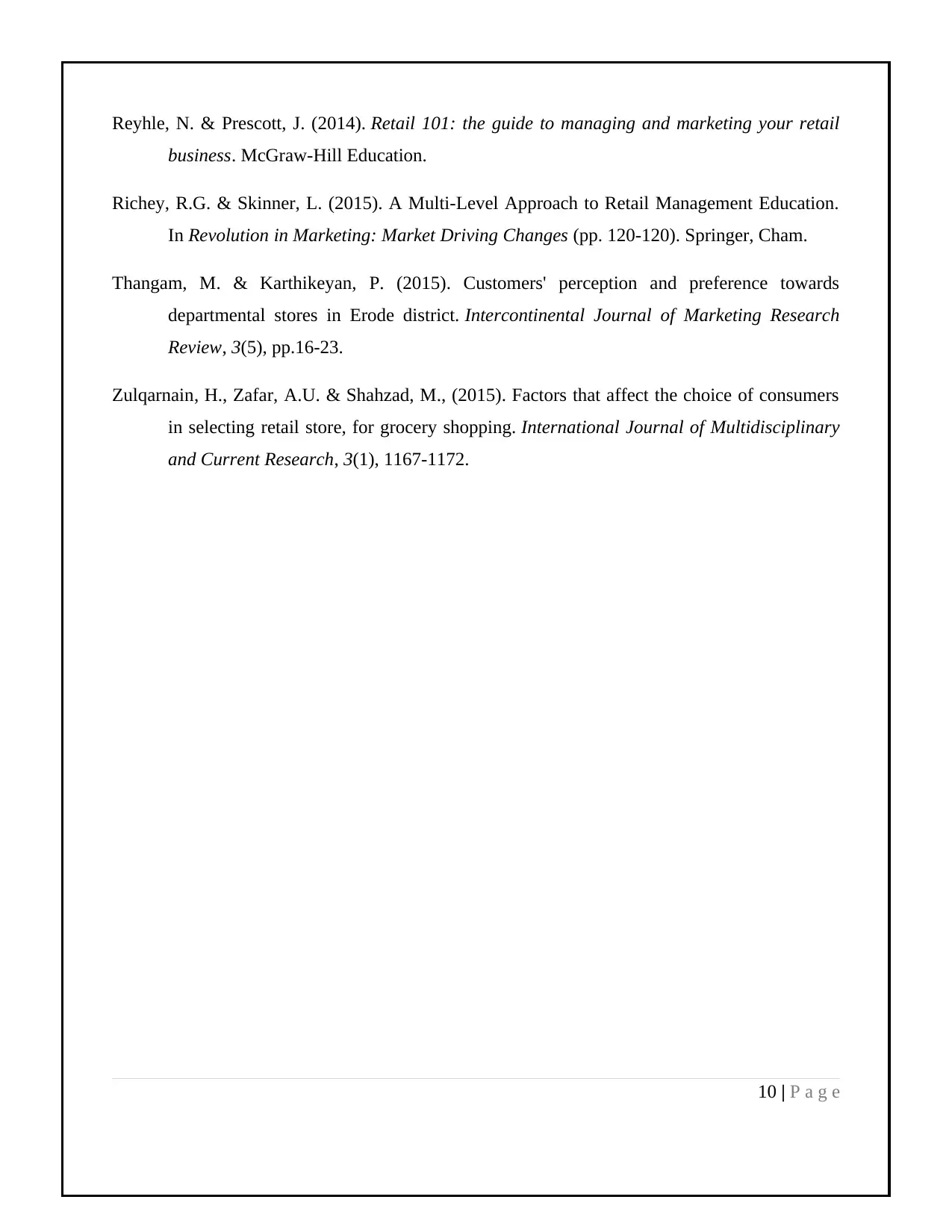
Reyhle, N. & Prescott, J. (2014). Retail 101: the guide to managing and marketing your retail
business. McGraw-Hill Education.
Richey, R.G. & Skinner, L. (2015). A Multi-Level Approach to Retail Management Education.
In Revolution in Marketing: Market Driving Changes (pp. 120-120). Springer, Cham.
Thangam, M. & Karthikeyan, P. (2015). Customers' perception and preference towards
departmental stores in Erode district. Intercontinental Journal of Marketing Research
Review, 3(5), pp.16-23.
Zulqarnain, H., Zafar, A.U. & Shahzad, M., (2015). Factors that affect the choice of consumers
in selecting retail store, for grocery shopping. International Journal of Multidisciplinary
and Current Research, 3(1), 1167-1172.
10 | P a g e
business. McGraw-Hill Education.
Richey, R.G. & Skinner, L. (2015). A Multi-Level Approach to Retail Management Education.
In Revolution in Marketing: Market Driving Changes (pp. 120-120). Springer, Cham.
Thangam, M. & Karthikeyan, P. (2015). Customers' perception and preference towards
departmental stores in Erode district. Intercontinental Journal of Marketing Research
Review, 3(5), pp.16-23.
Zulqarnain, H., Zafar, A.U. & Shahzad, M., (2015). Factors that affect the choice of consumers
in selecting retail store, for grocery shopping. International Journal of Multidisciplinary
and Current Research, 3(1), 1167-1172.
10 | P a g e
1 out of 10
Related Documents
Your All-in-One AI-Powered Toolkit for Academic Success.
+13062052269
info@desklib.com
Available 24*7 on WhatsApp / Email
![[object Object]](/_next/static/media/star-bottom.7253800d.svg)
Unlock your academic potential
Copyright © 2020–2025 A2Z Services. All Rights Reserved. Developed and managed by ZUCOL.



